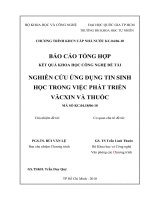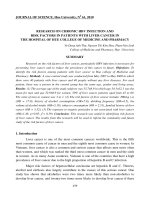HIS chapter 5 ( Tin Y học trong bệnh viện)
Bạn đang xem bản rút gọn của tài liệu. Xem và tải ngay bản đầy đủ của tài liệu tại đây (266.09 KB, 19 trang )
Reinhold Haux Alfred Winter
Elske Ammenwerth Birgit Brigl
Strategic Information
Management in Hospitals
An Introduction to Hospital
Information Systems
With 106 Illustrations
Status: May 2002 (Version 0.22)
Contents
1INTRODUCTION
1.1
1.2
1.3
1.4
1.5
1.6
SIGNIFICANCE OF INFORMATION PROCESSING IN HOSPITALS
PROGRESS IN INFORMATION AND COMMUNICATION TECHNOLOGY
IMPORTANCE OF SYSTEMATIC INFORMATION MANAGEMENT
EXAMPLES
EXERCISES
SUMMARY
2BASIC CONCEPTS
2.1
2.2
2.3
2.4
2.5
2.6
2.7
2.8
2.9
INTRODUCTION
DATA, INFORMATION AND KNOWLEDGE
INFORMATION SYSTEMS AND THEIR COMPONENTS
HOSPITAL INFORMATION SYSTEMS
HEALTH INFORMATION SYSTEMS
INFORMATION MANAGEMENT IN HOSPITALS
EXAMPLES
EXERCISES
SUMMARY
3WHAT DO HOSPITAL INFORMATION SYSTEMS LOOK LIKE?
3.1
3.2
3.3
3.4
3.5
3.6
3.7
3.8
3.9
INTRODUCTION
HOSPITAL FUNCTIONS
MODELING HOSPITAL INFORMATION SYSTEMS
A METAMODEL FOR MODELING HIS: 3LGM
INFORMATION PROCESSING TOOLS IN HOSPITALS
ARCHITECTURES OF HOSPITAL INFORMATION SYSTEMS
EXAMPLES
EXERCISES
SUMMARY
1
1
4
8
12
16
17
18
18
18
19
22
24
25
26
28
30
33
33
33
43
58
67
83
93
100
101
4HOW TO STRATEGICALLY MANAGE HOSPITAL INFORMATION
SYSTEMS
103
4.1
4.2
4.3
4.4
4.5
4.6
4.7
4.8
4.9
INTRODUCTION
103
STRATEGIC, TACTICAL AND OPERATIONAL INFORMATION MANAGEMENT 103
ORGANIZATIONAL STRUCTURES FOR INFORMATION MANAGEMENT
110
STRATEGIC PLANNING OF HOSPITAL INFORMATION SYSTEMS
116
STRATEGIC MONITORING OF HOSPITAL INFORMATION SYSTEMS
127
STRATEGIC DIRECTING OF HOSPITAL INFORMATION SYSTEMS
137
EXAMPLES
139
EXERCISES
139
SUMMARY
141
5WHAT ARE GOOD HOSPITAL INFORMATION SYSTEMS?
143
5.1
5.2
5.3
5.4
5.5
5.6
5.7
INTRODUCTION
QUALITY OF STRUCTURES
QUALITY OF PROCESSES
OUTCOME QUALITY
EXAMPLES
EXERCISES
SUMMARY
143
144
152
155
158
158
158
6FINAL REMARKS
159
7APPENDIX A: THESAURUS
161
8APPENDIX B: BIBLIOGRAPHY
162
8.1
8.2
8.3
8.4
8.5
8.6
BOOKS
PROCEEDINGS
JOURNALS
ASSOCIATIONS
INTERNET RESOURCES
RECOMMENDATIONS
162
163
163
163
164
165
9APPENDIX C: LIST OF EXAMPLES AND EXERCISES
166
10 APPENDIX D: LIST OF FIGURES AND TABLES
169
11 ABOUT THE AUTHORS
172
5
5
5.1
What Are Good Hospital Information Systems?
Introduction
Quality in general is the ability to meet all the expectations of the purchaser
of goods or services: “The totality of features and characteristics of a product or
service that bear on its ability to satisfy stated or implied needs"52
According to Donabedian, there are three major approaches to quality
assessment: quality of structures, quality of processes, and outcome quality.53 In
the context of health care, the concept of quality of structures includes the
human, physical, and financial resources that are needed to provide medical care
(e.g. educational level of staff, availability of medical equipment). Quality of
processes describes the quality of activities going on within and between
providers and patients (e.g., adherence to professional standards, appropriateness
of care). Finally, outcome quality describes the effects of patient care, i.e. the
changes in the health status of the patient (e.g. mortality, morbidity, costs).
While structure quality influences process quality, this in turn influences
outcome quality.
Those concepts can be transferred to hospital information systems: In this
context, quality of structures refers to the availability of technical or human
resources needed for information processing (e.g. number and availability of
computer systems, computer knowledge of staff). Quality of processes deals with
the quality of the information processes themselves which are necessary to meet
the user’s needs. Outcome quality describes whether the goals of information
management have been reached, or, in a broader sense, to what extent the
hospital information system contributes to the goals of the hospital.
Quality characteristics for hospital information systems help to describe the
‘fitness’ of a HIS, and finding diagnosis and therapy of ‘HIS diseases’.
It may not be so difficult to describe what a really ‘bad’ hospital information
system looks like. But what are characteristics and features of a ‘good’ hospital
information system? In this chapter, we will introduce the most essential ones.
After this chapter, you should be able to answer the following questions:
52 ISO. International Standard ISO 9000:2000. Quality management systems Fundamentals and vocabulary. International Organization for Standardization,
International Electrotechnical Commission, Geneva; 2000.
53 Donabedian A. Explorations in quality assessing and monitoring - Vol 2: The criteria and
standards of quality. Ann Arbor: Health Administration Press; 1982.
144
Strategic Information Management in Hospitals
• Which facets of quality have to be considered?
• What are characteristics for structure quality (i.e. the quality of
information processing tools, of HIS architectures, and of information
management), and how can they be assessed?
• What are characteristics for the quality of information processes, and how
can they be assessed?
• What are characteristics for the quality of outcomes, and how can they be
assessed?
5.2
Quality of structures
In the context of health care, the concept of quality of structures includes the
human, physical, and financial resources that are needed to proved medical care
(e.g. educational level of staff, availability of medical equipment).
In the context of hospital information systems, the quality of structures refers
to the availability of technical or human resources needed for information
processing (e.g. number and availability of computer systems, computer
knowledge of staff). It comprises quality characteristics for information
processing tools, for HIS architectures, and for information management in
hospitals.
Quality of information processing tools
Different characteristics of the computer-based or conventional information
processing tools used influence structure quality which can be separated into
software quality and hardware quality. In general, only a missing or erroneous
information processing tool should attract attention.
Software quality
The main characteristics of software quality have been defined by ISO
912654. The objective of this standard is to provide a framework for the
evaluation of software quality. ISO 9126 sets out six quality characteristics with
corresponding sub-characteristics:
• Functionality: Are the required functions available in the software?
• Reliability: How reliable is the software?
• Usability: Is the software easy to use?
• Efficiency: How efficient is the software?
54 ISO. International Standard ISO/IEC 9126-1. Information technology -- Software
product evaluation -- Quality characteristics and guidelines for their use. International
Organization for Standardization, International Electrotechnical Commission, Geneva;
2001.
5. What are good Hospital Information Systems
• Maintainability: How easy is it to modify the software?
• Portability: How easy is it to transfer the software to another
environment?
ISO 924155 specifically deals with software ergonomy. It contains 17 parts.
Part 10 of this standard deals with dialogue principles for user interface design.
The dialogue principles of ISO 9241 comprise:
• Suitability for the task: Does the user interface support the user to fulfil
his tasks effectively and efficiently?
• Suitability for learning: Is the user being supported to learn and use the
user interface?
• Suitability for individualization: Can the user interface be adapted to the
tasks and to the individual skills and wishes of the user?
• Conformity with user expectations: Is the user interface consistent and
adapted to the characteristics of the user (i.e. his knowledge, skill and
expectations)?
• Self descriptiveness: Is each step of the user interface understandabe for
the user by providing direct feedback or explanation?
• Controllability: Can the user, after having initiated the first step, control
the flow and speed
of tasks, until the
aim is reached?
• Error tolerance: Can
the aim of the task
even be reached
following obviously
wrong input by the
user, either with no
or little effort for
correction?
Hardware quality
Their are no explicit
Figure 100: An ease-to-use, stable, mobile information
norms to define the quality
processing tool: Paper-based documentation at the
of hardware or of physical
patients bedside.
information
processing
tools in general. However, many aspects of software quality can be transferred to
both computer-based and conventional physical tools.
The quality of physical information processing tools can thus be described by
the following characteristics:
55 ISO. International Standard ISO 9241. Ergonomics requirements for office work
with visual display terminals (VDTs). Genf: International Organization for Standardization,
International Electrotechnical Commission; 1993.
145
146
Strategic Information Management in Hospitals
•
•
•
•
•
•
•
•
•
•
•
•
usefulness (e.g. offering useful functionality for the user)
appropriateness (e.g. not dominating the physician-patient relation)
easy to use
available (e.g. mobile tool, see Figure 100)
multi-purpose
(e.g.
personal
digital
assistant)
efficient (low cost for
purchase and support)
flexibility (e.g. can be
modified easily, see
Figure 101)
stable
secure (e.g. supporting
basic data security and
data safety)
Figure 101: A bed as flexible tool, also
harmless (e.g. not
supporting information processing tasks.
putting harm on the
user of the patient)
usable (e.g. user friendly)
standardized (e.g. standardized form for order entry)
Quality of HIS architecture
HIS architecture should be organized in such a way that the different
computer-based and conventional information processing tools can work
smoothly and efficiently together, in order to provide a maximum quality of
information processing by the information system as a whole. Quality of HIS
architecture can display various characteristics: adaptability and maintenance,
homogeneity vs. heterogeneity, integration aspects, object identity, data integrity,
and functional mapping characteristics.
Adaptability and maintenance
In general, the architecture should be sufficiently flexible to be able to adapt
to the changing needs of the hospital. For example, new computer-based
application components should easily be added to the information systems,
application components should be easily replaceable by other (better) application
components, or the available bandwidth of the network infrastructure should
easily be extended in order to match rising quantity of communicated data.
5. What are good Hospital Information Systems
Homogeneity vs. Heterogeneity
Information processing tools (both on the logical and on the physical tool
layer) should be as homogeneous as possible and as heterogeneous as necessary.
On the logical tool layer we often have to balance between the homogeneity
of the hospital information system and the functional requirements of specific
departments.
On the physical tool layer, the heterogeneity is often the consequence of the
constant development of the HIS, e.g. comprising different generations of
computer systems. This could only be prevented when all physical data process
components are regularly exchanged together, which is normally not feasible.
In general, homogeneous information processing tools make training and
support of users easier and thus leads to reduced costs for the HIS.
Aspects of Integration
In a heterogeneous HIS architecture with various communicating application
systems and physical data processing components, all components must
smoothly work together. This is called integration, being defined as combining
or adding parts to make a unified whole.
In general, integration needs standards (e.g. for communication, user
interface design, installation routines
etc.), as well as a strict organization
(e.g. a systematically built up network
structure). The quality of integration
can be described by various integration
characteristics:
Hardware integration means that
the different physical data processing
tools should be interconnected in order
to avoid technical stand-alone-systems.
Hardware integration can be realized,
for example, by networking stationary
computers, and by mobile computers
connected via infrared or wireless
networks.
Access integration describes that
all user relevant clinical functionality
Figure 102: Insufficient access
should be accessible from the health
integration at the health care
care professional workstation. All
professional workstation.
relevant
application
components
should be available on one physical
data processing component (see Figure 102).
Presentation integration means that data from different applications are
presented in an adequate and consistent way. There should thus be e.g. a uniform
147
148
Strategic Information Management in Hospitals
graphical user interface and an overall uniform behavior for all user-related
functions on the health care professional workstation.
Data integration comprises that data should only be recorded once and then
be reused multiple times, in order to avoid duplication of data (single recording
– multiple use). Data which is registered in one application component should
thus be made available to other application components. For example,
administrative patient data should be documented once in the patient
management system and then be reused in other application components such as
dedicated documentation systems. To achieve data integration, the HIS should
have a global data model with clearly defined semantics of its concepts which
should be revealed for the integration of new application components.
Communication integration describes that application components should be
able to exchange information by using standardized messages. This is the
precondition for data and function integration in a DBn HIS architecture.
Function integration means that a specific functionality (such as patient
admission) which is offered by one application component, can also be used by
other application components. New application components should therefore be
designed so that functionality existing in prevailing application components are
used. To achieve function integration, a HIS should include a repository of
services offered globally.
Visual integration comprises that the application context is maintained when
the user changes the application component (e.g. because the functionality he
wants to use is only offered by another application component).56 A task which
has already been completed should not be repeated again. For example, on a
ward, there may be two application components, one for report writing, the other
for presentation of radiology results. When a physician is just writing a report, he
may want to look up the recent radiology results. When he shifts the application
component, the radiology results of his patient should immediately be displayed,
without forcing him to enter a name, birthday of patient or identification number
again. Thus, in this example, the selection of the patient is a task which must not
be repeated if performed once, even when changing the application component.
Object identity
Each object in the hospital (such as patient, case, user, department) should be
identified by a unique identifier.
Data integrity
Data integrity means that at each point in time, redundant data is identical in
each database where it is stored. Changes of data in one application component’s
56 The Clinical Context Object Workgroup (CCOW) published standards for visual
integration of independent application components, see Standard CCOW:
/>
5. What are good Hospital Information Systems
database must therefore be communicated and reconstructed in the other
application component’s databases where this data is also stored.
Data integrity is especially important when data is stored redundantly in
different locations in a DBn architecture. For example, when the patient
administration system changes the name of the patient (e.g. correction of the
name of the patient), this change has to be communicated to other application
components such as the medical documentation systems or the ward management
system which also have databases containing the patient’s name.
Functional mapping characteristics
With regard to HIS architecture, functional mapping characteristics describe
the quality of mapping between hospital functions and application components.
Functional leanness describes a situation where one hospital function is
supported by one and only one application component. The contrast is functional
redundancy or functional overlap which means that a hospital function is
supported by more than one application component. For example, patient
admission may be available in different application components. In order to get a
functional lean HIS architecture, only one application component should be used
for patient admission. Functional leanness is greatly facilitated by functional
integration and visual integration.
Functional completeness means that each hospital function is supported by at
least one application component. There is no hospital function which is not
supported by the hospital information system.
When both characteristics are fulfilled, then we can say that a
(sub)information systems has functional correspondence.
An application system is superfluous when it does not support a hospital
function.
Quality of information management
Several characteristics can be defined for the quality of information
management.
Clear decision structures, roles and responsibilities
Clear decision structures, roles and responsibilities should be defined for
information management’s organization. The responsibility for strategic, tactical
and operational management must clearly been established and known to each
staff member. The role of a CIO as well as of other important groups (such as
committees, support centers, or key users) should be explicitly defined and made
known. In general, it is useful to define the most important roles and
responsibilities in the hospital’s information management plan.
149
150
Strategic Information Management in Hospitals
Systematic strategic information management
A strategic information management plan should be defined and adapted by
the hospital management. A strategic plan should encompass the hospital
business strategy or strategic goals, the resulting information management
strategies, the current state of the hospital information system, and an analysis of
how well the current information system fits to the strategies. The planned
architecture should be derived as a conclusion of this analysis.
Systematic tactical information management
Information processing projects should be planned, management and
controlled in a systematic and transparent way. Project management standards
should be developed and used. Project groups and project committees should
comprise all relevant health professional groups. Systematic project controlling
should be established.
Information systems components should only be selected and introduced
after a thorough analysis of needs and costs and a transparent selection process.
When new computer-based application components are introduced, migration
strategies for the transformation of data are to be established and used.
Employee training
New users should be trained in basic information processing tools as well as
in the task-specific application components on a regular basis. The installation of
a training center and a training group is useful in order to offer efficient training.
Renewed training sessions should be offered when new functionality or new
application components are being introduced, or when deficiencies in users skills
have been found. The effects of users training should be regularly monitored.
Support strategy
An appropriate support strategy should be defined which helps to guarantee
the continuous and faultless operation of the information processing tools. This
support strategy should define different support levels for user and information
processing tools, as well as the problem management strategy. The users should
know about their contact in case of hardware or software problems.
Motivation and competence of IT staff
The IT staff represent a service provider for the user. Their motivation and
competence is essential for the efficient functioning of the information systems
and for a high acceptance by the users. The IT staff should therefore be
sufficiently and regularly trained, they should know the clinical workflow and
typical user problems, and they should be sufficiently motivated.
5. What are good Hospital Information Systems
Examples
Exercises
Summary
151
152
5.3
Strategic Information Management in Hospitals
Quality of processes
In general, quality of processes describes the quality of activities going on
within and between providers and patients (e.g., adherence to professional
standards, or appropriateness of care). In the context of hospital information
systems, process quality deals with the quality of the information processes
themselves which are necessary to meet the user’s needs.
Multiple usability of data
Application components often need the same data. For example, patient
administrative data or basic medical data is needed by many different application
components. In order to avoid duplicate data entry, which is inefficient and
prone to error, data should only be recorded once, even when it is used by
different application components and stored in different databases. This multiple
usability of data requires communication interfaces in the computer-supported
part of HIS, and ways to print out data (e.g. labels, order entry forms) or scan
data in order to provide communication between the computer-supported and the
not computer-supported part of HIS.
No transcription of data
Transcription of data should be
avoided. Transcription means to
transfer data from one storage
device to another storage device,
e.g. to transfer patient diagnoses
from the patient record to an order
entry form, or to enter data from a
print-out into a computer-based
application component (see Figure
103 and 104). Transcription
usually leads to the duplication of
data. This has to be avoided as it is
time-consuming
and
possibly
erroneous. Transcription is usually
combined with a change of the
media (media crack), but can also
include the transfer e.g. from paper
to paper.
Figure 103: Example of a transcription (1).
Figure 104: Example of a transcription (2).
5. What are good Hospital Information Systems
Leanness of information processing tools
The user wants to use as few application components and information
processing tools as possible for a given tasks. For example, during nursing
documentation, how often does a nurse have to change between application
components and information processing tools? The less application components
that have to be used for one tasks, the easier it is to avoid transcription.
Workflow integration
In general, new computer-based systems should be smoothly integrated into
the daily clinical workflow. Thus, their functionality and usability should match
the needs of the users and their typical tasks. The new computer-based system
must therefore smoothly work together with the other computer-based and
conventional information processing tools. Achieving such workflow integration
is the most important task from the user's point of view.
Efficiency and effectiveness of information logistics
Information processes should be as lean as possible: They should not contain
unnecessary steps (e.g. documentation of data which is never used again), they
should be as parallel as possible, allow the multiple usability of data (see above),
and avoid redundant activities (e.g. transcription of data, see above).
In general, information logistics should be organized as efficiently and
effectively as possible:
• The right information: is the information accessible, correct and complete?
For example, does the received lab result really belong to the displayed
patient?
• At the right time: Is the
information available when
the clinician needs it, just
in time? For example, are
the recent results available
during the physician’s
round?
• At the right place: Is the
information
available
wherever the clinical needs
it? For example, is nursing
documentation available at
the patient’s bedside as
well as in the ward room?
Figure 105: In a senior physician’s office:
• To the right people: Is the
Insufficient organization of work using paper-based
information only available
tools.
to the clinicians needing it?
For example, are the
153
154
•
Strategic Information Management in Hospitals
diagnoses of a patient only available to the treating clinicians?
In the right form: is the information available in a format usable to the
clinician? For example, can information personally be filtered, not
overwhelming the clinician with too much information (information
overload)?
Examples
Exercises
Summary
5. What are good Hospital Information Systems
5.4
Outcome quality
In general, outcome quality describes the effects of patient care, i.e. the
changes in the health status of the patient (e.g. mortality, morbidity, costs). In the
context of hospital information systems, outcome quality describes whether the
goals of information management have been reached, or, in a broader sense, to
what extent the hospital information system contributed to the goals of the
hospital.
Quality of outcomes thus means whether the hospital information system
finally fulfills the needs of its different user groups and thus supports efficient
and effective patient care. Outcome quality describes the measurable value of the
HIS for the hospital and its various stakeholders. Despite good quality of
structures and processes, it is not sure, that the hospital information system
contributes to the aims of the hospital or the expectations of the stakeholders.
Quality of structure and quality of processes is just a prerequisite for the quality
of outcomes.
Goals of the hospital
For the hospital as an enterprise, it may be interesting if the hospital
information systems contributes to
• Quality improvement
• Patient satisfaction
• Cost reduction
as general aims of all hospitals. Additionally, there are further hospital aims, like
• fulfillment of legal requirements
• support of clinical research
• being a specialized medical competence center
Furthermore, each individual hospital wants to attain further specific goals,
where the HIS should participate. For example:
• Efficient communication with other health providers (e.g. quick
communication of discharge reports to the next health provider)
• During patients stay, all patient-related information is available.
Goals of information management
Usually, in each country, different laws influencing information processing
can be found, dealing for example with organization of health care, financing of
health care, health statistics, or data protection. Those laws must be taken into
account by information management.
155
156
Strategic Information Management in Hospitals
Expectations of different stakeholders
As well, distinct stakeholders have specific expectations. User needs
typically to be addressed comprise:
• Patient: availability of up-to-date medical knowledge, staff which has
time for the patient, not wasting time on unnecessary documentation
tasks or inflexible information processing tools.
• Relatives: the patient can easily be found in the hospital, information for
home care is made available.
• Physician: new findings are available at the physician’s round, not losing
time with insufficiently designed information processing tools, multiple
usability of data, availability of the whole patient record, simple and
standardized forms for data entry, easy access to new medical
knowledge.
• Nurses: easy procedure for scheduling and order entry, availability of
bedside documentation tools, support of ward organization, easy access
to nursing guidelines and to nursing knowledge.
• Administration staff: availability of up-to-date administrative
information, efficient tools to support billing and financial budgeting.
• Hospital management: easy access to complete and up-to-date
information on the quality of patient care and on its costs.
Examples
Legal issues: German laws influencing hospital information systems
The organization of health care in Germany is described in the
"Sozialgesetzbuch V" (SGBV). In contains among others laws about quality
management, administrative health cards, and data exchange of diagnoses and
services for inpatients and outpatients between hospital and insurance
companies. The hospital financing system is regulated in the
"Krankenhausfinanzierungsgesetz"
(KHG),
together
with
the
Bundespflegesatzverordnung (BPflV). The amount of reimbursement for
outpatient care is described in different catalogues such as GOÄ, EBM and
DKG-NT.
There are several laws concerning data protection: The national data
protection law (Bundesdatenschutzgesetz) and the regional data protection laws
(Landesdatenschutzgesetze) describe, among others, technical and organizational
means to protect sensitive data. In addition, the regional hospital laws
(Landeskrankenhausgesetze) regulate among others if the data collection, storage
and use of patient centered data in hospitals is permitted. The hospital statistics
law (Krankenhausstatistik-Verordnung) contains guidelines for federal-wide
statistics about diagnoses and other health data and about cost data.
5. What are good Hospital Information Systems
The regional archive laws (Landesarchivgesetze) deal with archiving of
documents such as patient records. The information and communication service
law (Informations- und Kommunikationsdienste-Gesetz, IuKDG) introduces the
digital signature and contains guidelines for the use of telecommunication
services. Further information is given in the Signaturverordnung (SigV).
For university medical centers, the HBFG (Hochschulbauförderungsgesetz)
deals with building and modernizing medical centers and describes the financing
of medical devices such as computer systems. The MedGV (Medizinische
Geräteveordnung) describes documentation and maintenance of the medical
devices.
Overall, there is a vast amount of different and often changing laws which
provide a framework for information processing in inpatient and outpatient care.
Exercises
Summary
157
158
Strategic Information Management in Hospitals
5.5
Examples
5.6
Exercises
5.7
Summary









